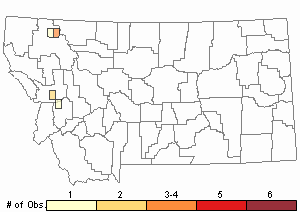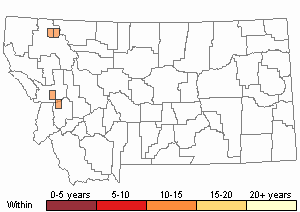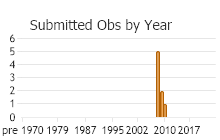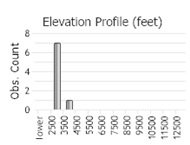View in other NatureServe Network Field Guides
NatureServe
Montana
Utah
Wyoming
Idaho
Wisconsin
British Columbia
South Carolina
Yukon
California
New York
Brown-banded Arion Slug - Arion circumscriptus
Other Names:
Arion fasciatus
General Description
A small to medium-sized slug, reaching 25 to 40 mm extended. Dorsal base color is gray, sometimes lighter on the sides, tentacles dark. The mantle is granulose, about 1/3 the body length, and the same color as the back, marked with numerous small dark spots bounded by a pair of brownish lateral bands close to the mantle margin. The pneumostome is in the anterior half of the mantle on the right side, posterior to the mantle cleft. The tail has a pair of brownish or darker gray lateral bands extending to near the posterior end, lacks a mid-dorsal keel, and is covered dorsally with many fine tubercles in a series of rows. The sole is very pale, undivided (lacking two longitudinal furrows), the mucous clear and not sticky (Hendricks 2012, Burke 2013). Internal anatomy is described by Pilsbry (1948) and Forsyth (2004).
Diagnostic Characteristics
Arion lack an elevated visceral hump, possess a mantle about 1/3 the length of the animal, have an undivided foot and lack a dorsal keel on the tail, have a relatively broad tail with a caudal mucous pit at the tip where the pedal furrows meet, and a pneumostome in the anterior half of the mantle. A. circumscriptus differs from other members of the genus by a combination of it's small to medium size, dark gray to brown color (paler on sides) with thin dark line on sides of mantle and tail, clear mucous, and presence of small black speckles on the mantle.
Species Range
Montana Range
Range Descriptions

 Non-native
Non-native
Range Comments
Native to Europe, introduced to North America (Burke 2013). In Montana, reported from Flathead, Granite, and Missoula counties, all west of the Continental Divide, although records of A. fasciatus (Orange-banded Arion) from Lincoln and Missoula counties probably reprsent this species. Present at several locations in the McDonald Creek drainage of Glacier National Park. Elevation range is 963 to 1251 m (3160 to 4105 ft). Not reported in Montana prior to 2006, but with additional surveys in appropriate sites it will probably prove to be one of the most widely distributed Arion in areas of human activity west of the Continental Divide. As many as 25 individuals were reported at one Missoula County site in early May (Hendricks 2012).
Observations in Montana Natural Heritage Program Database
Number of Observations: 8
(Click on the following maps and charts to see full sized version)
Map Help and Descriptions
Relative Density

Recency



 (Observations spanning multiple months or years are excluded from time charts)
(Observations spanning multiple months or years are excluded from time charts)
Habitat
Occupies moist to wet sites (stream-sides, marshy areas) within forested or shrubby locations, usually near areas of human activity, such as campgrounds, gardens and other disturbed sites. Canopy species include western redcedar, Engelmann spruce, western hemlock, grand fir, black cottonwood, aspen, mountain ash, and water birch, secondary canopy species include alder and mountain maple. Most often found under woody debris and rocks (Hendricks 2012).
Stewardship Responsibility
References
- Literature Cited AboveLegend:
 View Online Publication
View Online Publication Burke, T. E. 2013. Land snails and slugs of the Pacific Northwest. Corvallis, OR: Oregon State University Press. 344 p.
Burke, T. E. 2013. Land snails and slugs of the Pacific Northwest. Corvallis, OR: Oregon State University Press. 344 p. Forsyth, R.G. 2004. Land snails of British Columbia. Royal British Columbia Museum: Victoria, British Columbia, Canada. 188 pp.
Forsyth, R.G. 2004. Land snails of British Columbia. Royal British Columbia Museum: Victoria, British Columbia, Canada. 188 pp. Hendricks, P. 2012. A Guide to the Land Snails and Slugs of Montana. A report to the U.S. Forest Service - Region 1. Montana Natural Heritage Program, Helena, MT. vii + 187 pp. plus appendices.
Hendricks, P. 2012. A Guide to the Land Snails and Slugs of Montana. A report to the U.S. Forest Service - Region 1. Montana Natural Heritage Program, Helena, MT. vii + 187 pp. plus appendices. Pilsbry, H.A. 1948. Land Mollusca of North America (north of Mexico), Volume II Part 2. The Academy of Natural Sciences of Philadelphia Monograph Number 2(2): 521-1113.
Pilsbry, H.A. 1948. Land Mollusca of North America (north of Mexico), Volume II Part 2. The Academy of Natural Sciences of Philadelphia Monograph Number 2(2): 521-1113.
- Additional ReferencesLegend:
 View Online Publication
View Online Publication
Do you know of a citation we're missing? Frest, T.J. and E.J. Johannes. 2001. An annotated checklist of Idaho land and freshwater mollusks. Journal of the Idaho Academy of Science 36(2):1-51.
Frest, T.J. and E.J. Johannes. 2001. An annotated checklist of Idaho land and freshwater mollusks. Journal of the Idaho Academy of Science 36(2):1-51. Grimm, F.W., R.G. Forsyth, F.W. Schueler, and A. Karstad. 2009. Identifying land snails and slugs in Canada: introduced species and native genera. Canadian Food Inspection Agency, Ottawa, ON. 168 pp.
Grimm, F.W., R.G. Forsyth, F.W. Schueler, and A. Karstad. 2009. Identifying land snails and slugs in Canada: introduced species and native genera. Canadian Food Inspection Agency, Ottawa, ON. 168 pp.
- Web Search Engines for Articles on "Brown-banded Arion Slug"
- Additional Sources of Information Related to "Snails / Slugs"





